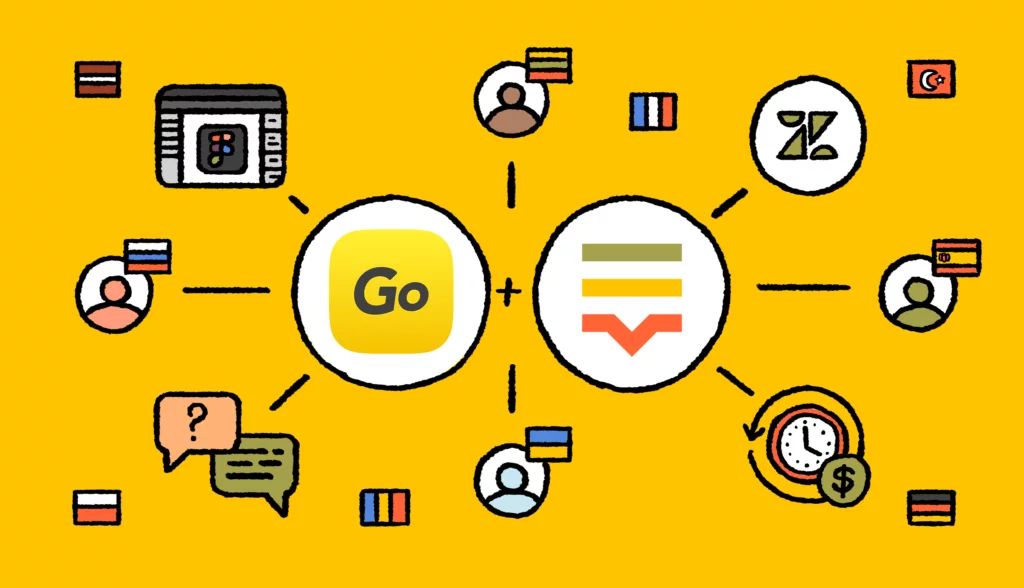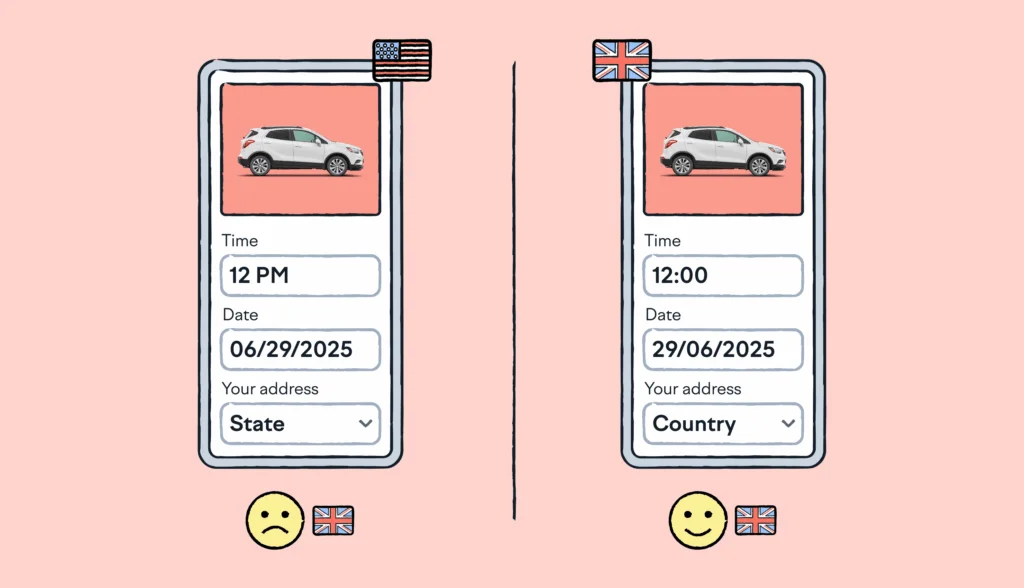How long does it take for you to send a single text message? Just a couple of seconds, depending on how fast you type, we presume.
Now, imagine you can send money to over 160 countries equally as quickly and pay up to 90% less than at the bank. The payment gets delivered digitally and securely in under 30 minutes.
Well, that’s what TransferGo enables you to do.
TransferGo makes international money transfers easier, mainly for migrants in Europe but also across the world. Their diverse, multilingual team consists of over 200 employees who all share the same goal: to make sending money overseas simpler and more affordable.
TransferGo makes real-time financial services that are personal and accessible to everyone, everywhere. As you’ve probably guessed, localization is an important part of the mix.
We sat down with Nadim Dimechkie, Director of Copy at TransferGo, to discuss how they handle localization, why it matters for fintech companies, and how Lokalise helps them in the process with its robust translation management features that streamline their workflows.
Key localization players at TransferGo
As the Director of Copy, Nadim is the one responsible for leading TransferGo’s localization efforts. We asked him to share more about how they take care of localization: is it all in-house, do they use LSPs, or perhaps rely on some other type of external partner?
Nadim reveals that there are basically three ways they handle localization through Lokalise:
- In-house guardians for each of the 9 languages
- Sending orders for translation in Lokalise
- Handpicking translators who are then included and plugged into Lokalise
Naturally, we were curious to find out more about what these guardians do and here’s what Nadim had to say:
“The in-house guardians for each of the 9 languages are basically individuals responsible for preserving the tone of voice in each respective language. They are always the last people to review everything that’s been localized.”
As we found out from Nadim, the guardians might translate something themselves, but we try to avoid this because they are not, primarily, writers. Their core job is to check and review both the source copy and the localized copy.
So, how do you actually achieve that?
Preserving the tone of voice while localizing
In fintech, it is extremely important that all the information available to users is accurate. So, how can a company protect its tone of voice while also adjusting to different markets? Nadim shared how they handle this at TransferGo:
“We have a massive tone of voice document in English, but for the benefit of the translation team, I always tend to write them a few words that capture the essence of it. For instance, I write ‘human, simple, friendly, direct.’ Because let’s face it: nobody will read a fifty-page document every single time.”
What was interesting for us to learn from Nadim is just how collaborative this process is. It’s rarely a single-person decision, especially when it comes to different linguistic choices:
“You need active conversations. It’s great to create a culture where people argue about language because getting the tone of voice right is very complicated.”
Also, Nadim shares, people often mistake consistency with being the same. But to succeed, you sometimes need to be a bit different for each language. Your tone of voice needs to be flexible enough for you to pull it off. And that, again, requires conversations.
Why is localization so important for fintech companies?
Localization is tightly connected to international growth regardless of the industry. But why is it so important in fintech? Nadim offered us his experience:
“Fintechs are all about personalization. Every successful platform out there makes the user feel like they are central. Their name is there, things are made accessible to them, they are made to feel in control, to clearly understand what’s happening. Localization is obviously an integral part of that.”
As a very user-centric industry that needs to be careful about regulations, infosecurity, and trust in general, fintech needs to ensure the best translation quality to delight their users:
“Money creates enough barriers in people’s lives, but language shouldn’t be one of them.”
But it’s not just about that bare minimum – making your product accessible in their language, says Nadim. Even the way the product works in different languages and countries is different:
“Regardless of the market, you have to have a tailored message that takes into account a lot of idiosyncrasies.”
An example where efficient localization truly made a difference for TransferGo
Nadim is a firm believer in the value of localization, especially in fintech. When we asked him to share an example of a time when localization truly made a difference for TransferGo, here’s what he told us:
“We decided we wanted to make our platform in French and Spanish. That’s maybe 200,000 words – web, mobile, emails, landing pages, etc. From a translation management perspective, it must have taken me 2-3 days total of my time, maybe even less.”
But it’s not even about the hours saved – it’s about how easy it was thanks to Lokalise, shares Nadim:
“We used the available translation service and it cost us around $20,000 in total, which is rather cheap for both languages and that number of words, and in such a short timeframe. The leadership team appreciated the fast turnaround and the cost-effectiveness of the project.”
The entire localization process was done in around 10 days, which is such a small period of time for conquering two languages (that means the entire product plus all the assets).
Agility and speed as key value points in fintech localization
Agility and speed are the primary values that TransferGo sees in fintech localization, but Nadim believes these apply beyond the industry. In general, for every company dealing with apps, agility and speed are good things to have, says Nadim:
In fintech – your main focus is usually on apps, which tends to involve very small, short communications across multiple languages and on multiple screens, says Nadim. This kind of granularity can be a nightmare to manage:
“Lokalise helped a lot with this, especially because it enabled us to streamline the flow of content between translators and developers. Developers can easily make or adopt changes and make them go live in an app immediately.”
Directing change management and supporting user adoption
Naturally, as localization software made by developers, for developers, Lokalise was initially used by the tech team at TransferGo:
“Lokalise wasn’t used by most of our departments in the beginning. For instance, customer support and most of our marketing teams didn’t use it. It was really only used for managing translations in the product itself.”
It took some time for Nadim and his team to learn how to get the most out of the software:
“At the beginning, there weren’t any workflows created, no automations, we had no idea how to check if a translated key was verified or not. It was a bit messy until we learned more, but it was certainly a lot cleaner than using a spreadsheet.”
Nadim shared how before, they weren’t even using ‘Create Task’ within Lokalise. They were either ordering translations externally or setting up a task in Asana, in Slack, or somewhere else. Things have changed, though:
“Thanks to integrations, people are now directed to the exact place they need to be, within the correct project in Lokalise. And the translation manager can see the status of every language, the level of completion, at a glance. There’s a lot less confusion.”
Nadim also revealed that, when it comes to spreadsheets, some of their users got really sophisticated. They had got used to this long way of doing it. However, he doesn’t hide the fact that he’s ‘team Lokalise’:
“Whenever I get a spreadsheet or Excel with a translation in it… I ask myself – why? Who sent me this and can I teach you about Lokalise? It’s going to make your life much easier.”
Saving time and money
One of the biggest challenges for someone in Nadim’s role is the lack of time. However, with the right tools, you can accelerate your localization process, automate some of the mundane tasks, and direct your focus where it matters most:
“I couldn’t believe how much time I was saving when I started using Lokalise. I was actually scared! With the press of a button, all of the languages changed. I thought to myself, ‘wow, this is incredibly powerful.’”
In terms of managing different translators and languages, Nadim shared that what used to take him 4 hours would now take him about 30 minutes – simply in terms of organization: setting tasks of translation or review, finding out what’s missing, chasing late translations, commenting on ongoing issues, etc.
“Using the Figma integration, it takes me about two hours to import all the copy from the design into Lokalise. This same process done manually would have taken developers a day and a half.”
The time-saving benefits go beyond the tool’s built-in features alone. It’s also about the proper guidance that prevents you from wandering in the dark while searching for answers:
“One thing that I really like about Lokalise is the customer support. It’s really, really good. So, our customer support team (which is also really, really good) had a problem with Lokalise. And they were all like, ‘Oh, but we don’t know how to use this.’ Then, I just said to them, ‘ask the Lokalise chat. Seriously. They will help you.’ And in five minutes, it was all sorted, it was all good,” shared Nadim.
Single source of truth for localization
Having a single source of truth is crucial, especially when you have a decentralized localization team:
“We value Lokalise because it’s our single source of truth. All of the tools we use (e.g., platforms for automated and transactional emails or Zendesk), are there thanks to the integrations. And this actually makes the inadequacies of other tools more bearable.”
The collaborative nature of the platform makes it easier to streamline communication and have a great top-view of the project. It’s easier to make decisions if you have a centralized workspace where all team members can effectively work together.
The future of TransferGo is bright
With more than 2.5 million users across the globe, TransferGo continues to enable fast, low-cost money transfers safely and securely.
The solution that TransferGo offers is brilliant, yet so simple: they actually don’t send money across borders. Yep, you read that right. Instead, you make a local payment to TransferGo and TransferGo makes a local payment to your recipients. Super easy.
And the result? Cheaper and faster transfers when you need them.
–
We would like to thank Nadim for this awesome talk! To find out more about why Lokalise is a good fit for fintech companies, visit this page.





